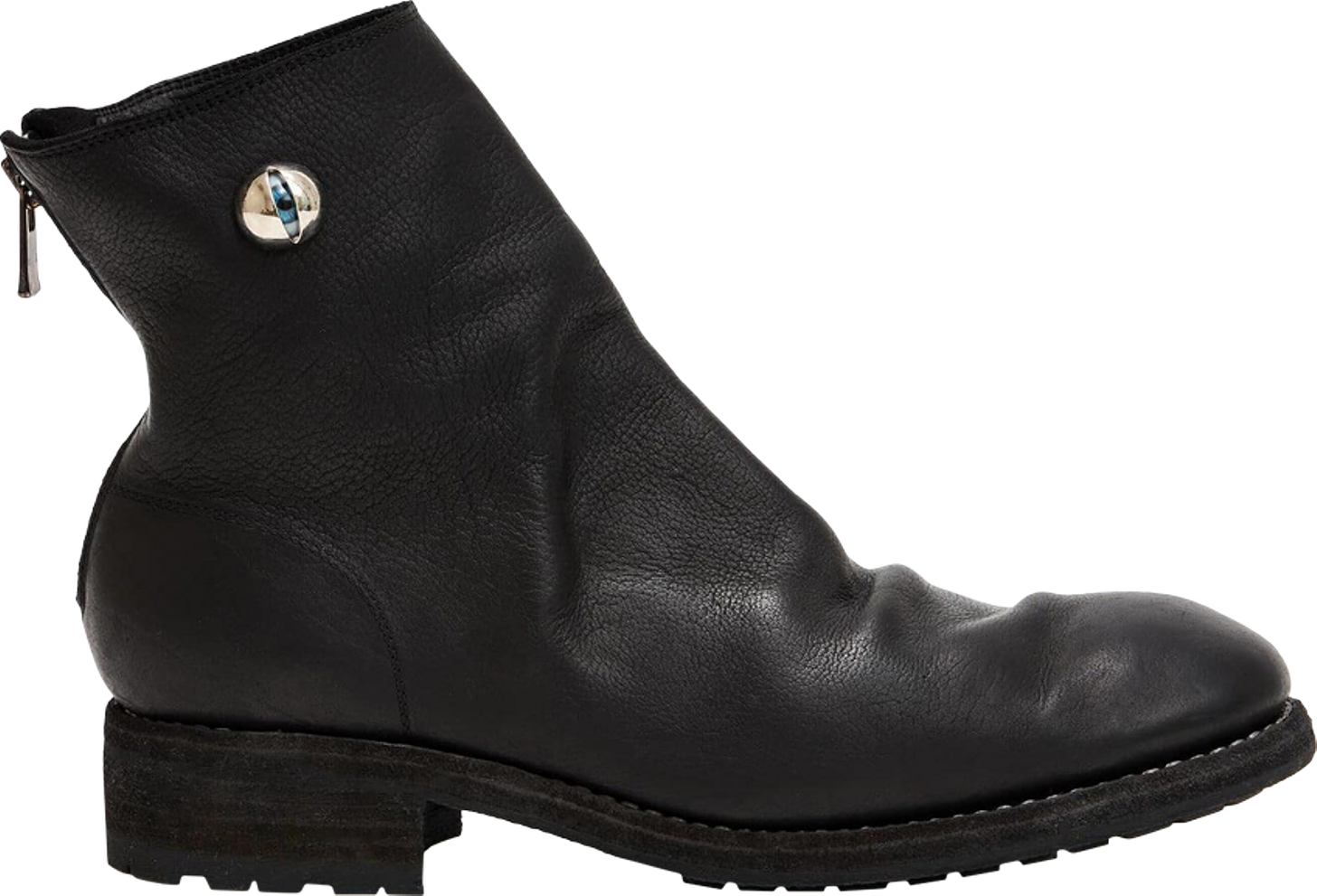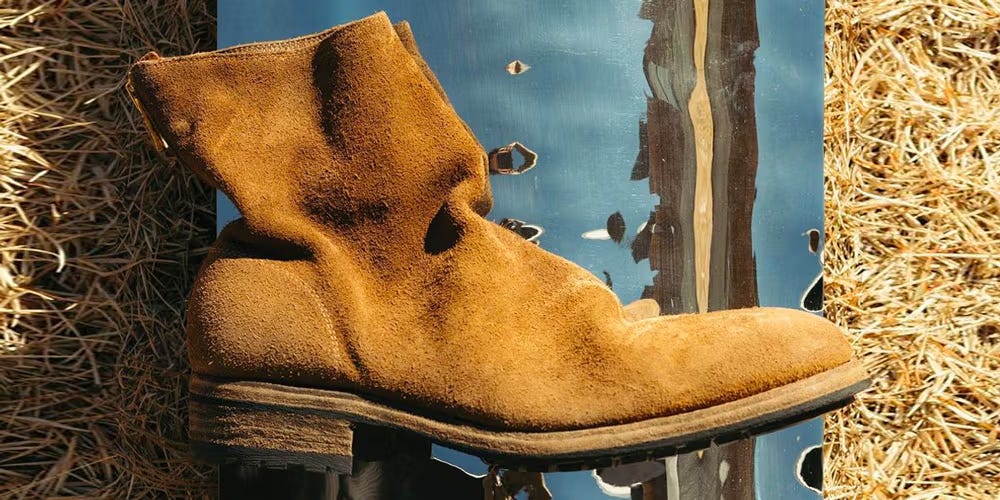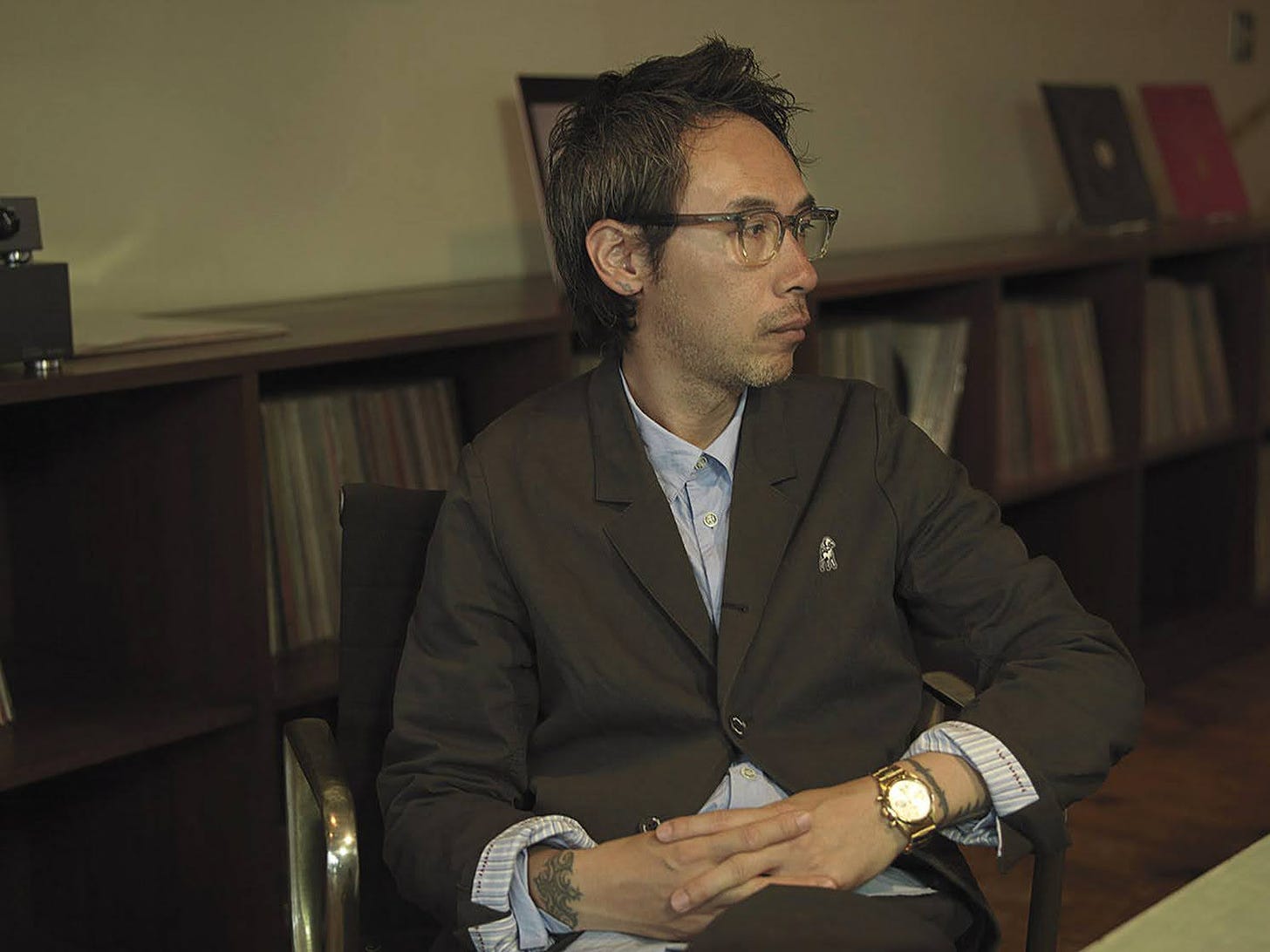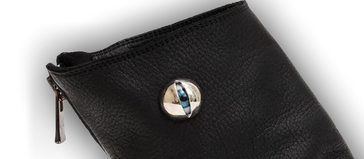To realize you are being stared at is to be totally disarmed. Unless you have seen your audience turn to examine you, there is no way of knowing how long you’ve been examined, or why. When a glance is more than a glance but a stare, it is something greater than banality - a desire, an anger, a question, a movement. Even accidental stares can set us off.
Last week, the person staring at me turned out to be a boot.
It’s an old boot now, a couple months old from Spring/Summer 2024 yet grizzled in a pebbly leather finish. It’s a Guidi boot with a back zipper, an Italian company popular among archive and menswear enthusiasts, including Undercover designer Jun Takahashi who worked with Guidi on the boots. For his SS22 collection when Takahashi released his first Guidi boots in distressed suede earthtones, he announced they had become his favorite shoes and that he wore them everyday. The new boots are similar in their utter normalcy, with the exception of a silver bulb that holds a startling realistic eyeball with electric blue pupils. Far away it’s a black boot, but when examining the boot’s leather and zipper it is as if you’re being sized up by the shoe itself.
The eye isn’t quite trompe l’oeil, there’s no real visual pun to the shoe’s silver bulb hiding a realistic eyeball. It’s just strange. The boot’s gleaming hardware sits shiny and new beside a grizzled shoe with leather prepared to weather decades. The eye is an indiscreet sign of craft and design, something to distract from the classicism of the boot. If the eye is to be seen as a sort of portal, it becomes a tool for assimilating and examining the decades the boot is meant to weather until eventually it too is aged, scuffed, and made “classic”.
You could wear this boot a million ways. It is obvious as a multi-thousand dollar piece of exclusive luxury fashion only to those adherents who meet its silver eye. A wearer could embody a million versions of Undercover’s different aesthetics, sure, but more broadly it illustrates a full and well-lived life. This boot is to be worn.
Jun Takahashi has built a decades-long reputation for fantastical and theatrical streetwear and subcultural fashion. There are reproductions of the costumes of Kubrick movies and punk legends, tee shirts for imaginary bands, and clothing for pantheons of superheroes and their inhuman foes. Even collections deemed “soulful” or “poetic” may feature a sheer dress containing live butterflies (this FW24 dress served as the poster for the latest Met Costume Institute exhibit). The “basics” Takahashi sells season to season feature his bold logos and motifs on tees and hoodies: a giant letter U, a teddy bear, a slogan in a bold Kruger serif. Takahashi is not famous for his minimalism.
Still, in 2016 Takahashi opened a new label under Undercover called The Shepherd which he described as "clothes I want to wear now”. The line is composed of tartan prints, crinkled zippers on stiff wool jackets, overcoats, baggy suits, MA-1 jackets, and glorious leather. It’s as if Vivienne Westwood never stopped making Seditionaries, only simplifying and heightening its quality (Takahashi is a legendary collector). Ultimately, The Shepherd is the expression of the designer’s daily uniform. It is his wildest sensibilities transmuted into basics, his childhood and future wrapped into a safety blanket.
For Takahashi’s SS16 show the same year, he celebrated 25 years of Undercover with reproductions and new versions of garments throughout his career. It brought the past into the present, commemorating old work with a new attention to how it is remembered, collected, and worn. Undercover is, after all, one of the canonical “archive“ brands - an object of obsession not by the fashion academy but by communities of rabid collectors and enthusiasts paroosing Grailed and frequenting 2nd St boutiques.
To give an example of this phenomenon: the most expensive Undercover item for sale on Grailed is a $65,000 cane used on the runway in 2019. The most expensive Prada item for sale is a $49,000 coat from 1989. Compare his SS16 show which spoke to this demand with The Shepherd. As an extension of Takahashi’s consistent closet rather than his whims, The Shepherd is something tweaked only when needed - the shows are infrequent and come at Takahashi’s will. The Shepherd has a staying power, a built-in timelessness. Takahashi is tasked with either submerging into the past to make work catering to his own archive or forming a “new“ and equally adored archive. Will he create for a lost past or a murky future?
Now, approaching 34 years of Undercover, Takahashi is thinking more about consolidating labels than starting new ones, mentioning in a recent SSENSE interview the idea of combining men’s and women’s runway presentations. He continues, “I think that the seasonal show system is questionable…Raf Simons said online that doing collections several times a year is too much, and I agree with him. I wonder why people are happy about things like holding a fashion show and going viral. I think it would be better if they could make things with a little more substance.”
While “substance“ does not always directly translate to wearability (see his FW24 butterfly terrarium dress), there is a question of when the endless clothes of a million sublabels and expensive shows/shoots overwhelm the ability to execute both high-concept avant-garde clothing and wearable garments. The Shepherd is produced when it is necessary, but the ethic of avant-inflected “basics“ highlighting craft has entered his recent work in other sublabels - enter the Guidi Boots.
Characteristic of the fashion system, these boots are about to leave shelves to make way for the Fall collections. They may already be gone. How many pairs of these boots were made? How many will you find on resell, and in your size? Will you ever stare into those smooth, alien eyes again?
This is the problem with such beautiful, affecting, timeless pieces crafted in the storm of a quickening and cheapening fashion pipeline: these boots are primed to disappear. This boot was not built for the temporal, for fashion’s modern sense of markets and “rising value“ or ironic attention to archive. They will be worn by those who buy them - never resold but instead resoled.
It is emotional to see a designer who has always relied on the lasting power of culture and high concept abandons these tools in favor of lasting materiality and affect. With these boots, Takahashi seems intent on being open and revelatory. He is accepting and mastering a new form of garment making before his fans and a fashion landscape hungrier than ever.
Meeting the gaze of that boot, I realized that this may be the last time we would meet. It was built to be worn so it will be - just not by me. This boot had a life and presence I would never know.
So I walked by, wondering just what else this boot would see.








